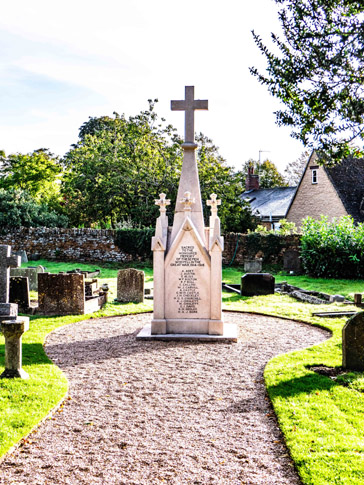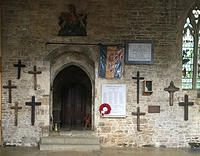Millennium Project
The contents of this article were researched by Rob Forsyth and given as a talk by Rev. Annie Goldthorp as part of a Poppy Appeal fund-raising event held in
Deddington Church on 29 October 2021.

The story of Deddington's War Memorial
...is not straightforward. First one must note that there were no rules or regulations at the close of The Great War in 1918 for erecting them. Before the nineteenth century they were seen as more of a celebratory object than one of mourning and sadness. They were built to celebrate great leaders and victories, not to commemorate ordinary servicemen or women.
This started to change with the Boer War of 1899-1902. The public perception of the lower ranks of the Armed Forces - and especially of volunteers - started to improve and more communities created local memorials to remember all those who had lost their lives.
The First World War was a turning point. Around two-thirds of the memorials that exist today date back to this war. There are several reasons for this: the sheer numbers of casualties; the fact that so many volunteers and civilians were affected compared to previous wars; and the ban on repatriation of the dead.
The idea for our memorial was first raised in May 1919 and a committee was soon formed chaired by Mr Bryan Millington who was a well-to-do farmer living at Leaden Porch House on New Street.
There is a personal connection here. Bryan’s next-door neighbours and good friends were Richard Bull the village Vet and his family living in what is now our house - The Stile House. Their son Reginald had been killed in action on 1 November 2018 only 10 days before the Armistice. This may well have been why Bryan took on the the Chairmanship of what proved to be a less than happy task. A memorial to Reginald is on the North wall above the crosses
A decision was quickly made that the War Memorial would be in the churchyard. This was unlike most other villages whose memorials are in the village centre. This may have been because the state of the market place was apparently very bad and unsightly. But there may have been another problem. The village had a large number of Wesleyan & Congregational church-goers who, by some accounts I have seen, did not like the incumbent vicar’s tendency to follow high church practices. So it may be – and here I am speculating – that not all grieving families may have wished their men to be memorialised in the ‘established' church’s churchyard. There are several extremely unseemly exchanges by notes and postcards between parishioners about location and costs in the Oxford Records Office!
This all caused delay. Mr Millington himself, in one note, says he is close to giving up the Chairmanship. Even the Diocesan authority - whose permission is required for any work on church property - seems to have prevaricated for a very long time over the design.
Although by August 1919 it had been agreed that the Memorial "would be designed by Mr Smithin, would be twelve feet 6 inches high, executed in Portland Stone and cost about £230" nothing really had happened even by January of the the next year such that the committee felt obliged to issue a public apology.
A whole year further on it had still not been completed. At which point a very angry lady called Miss Ellen Hands personally paid for a small brass plaque to be engraved and hung in the church in March 1921. It now hangs just inside the porch to the North door.
It was not until Sunday 6 August 1922 - over three years on from that first meeting - that the memorial we see today was finally unveiled by Major General Sir Robert Fanshawe KCB DSO. He had commanded the 48th (South Midland) Division on the Western Front and in Italy from 1915 until June 1918.
It was dedicated by the Vicar, Reverend Thomas Boniface, the Reverend T Buckingham represented the Wesleyan community and the Reverend J Carter represented the Congregationalists – clearly the established and non-conformist churches had come to an accommodation.
Wreaths were placed by parishioners and representatives of the Queen's Own Oxfordshire Hussars, while the bellringers tolled a muffled peal.
The names of 51 men were engraved on the memorial. Research has since revealed that there were a further 19 men who could have been considered by birth, marriage or residence. Their omission may have been because after the war their parents or wives had moved elsewhere and only those families still in the parish and whose sons were born in the parish were included. It also may have been that some Methodist or Congregational families still did not support the idea of the memorial being in the ‘established’ church yard. Once again I speculate on this. We will never know.
The full list of 70 men who died in WW1 came from a pool of only about 250 of military age in the parish – a very significant loss in a village largely consisting of agricultural labourers. Of these 70, five families bore the loss of more than one son. The Chislett, Hutt, Hawkins, & Tustain parents all lost two sons and the Tustains also lost several close nephews.
But a 5th family stands out from the rest. David & Ellen Hancox of Grove Lodge had four sons - Albert, William, Rufus and Arthur. All served in the army. The three youngest all died in action. It is hard to imagine the grief of their family and the pain with which their father, who was a woodcarver, personally created the wooden memorial to them that hangs high up near the font at the back of the church.
The Second World War saw 11 more names added to the Memorial. Our research found a further two men who deserve to be remembered by birth and residence, one of whom, Sgt Ken Harris RAF, had earned a Distinguished Flying Medal. They, along with the 19 missing names from WWI, are now included on a new Memorial Plaque on the North Wall dedicated in 2013 and paid for from the proceeds of sales of A Parish at War, the book I published recording the military history of this Parish in some detail. It is now out of print but can be read or downloaded from the Deddington History website.
In conclusion, whatever the troubles surrounding its creation, our Memorial today stands in dignity in its own peaceful setting, far from 21st Century traffic and noise in a place where “…at the going down of the sun, and in the morning…” we can remember the 86 Deddington men who lost their lives in war.
WWI War Grave Crosses
 In 1928 David Hancox took a small team of friends to France to look for his son's graves. They found Walter’s and Albert’s but not Rufus’. They brought their crosses back to Deddington and they now hang on the north Wall along with just two others that were recovered – Reginald Bull’s and Frederick Tustain's; the other five crosses are from the graves of those who died in England from war wounds or disease. They have CWGC headstones in the churchyard.
In 1928 David Hancox took a small team of friends to France to look for his son's graves. They found Walter’s and Albert’s but not Rufus’. They brought their crosses back to Deddington and they now hang on the north Wall along with just two others that were recovered – Reginald Bull’s and Frederick Tustain's; the other five crosses are from the graves of those who died in England from war wounds or disease. They have CWGC headstones in the churchyard.
More information about the crosses can be found HERE
A lighting display of the crosses and memorials on the church's north wall was created for the fund raising evening by Neil Skinner.
Click on the image for more photographs
2021 War Memorial Renovation
The 100th Anniversary of the founding of The Royal British Legion was marked by a major project to clean and restore the Memorial and to improve the landscaping around it, hard surface the paths from the Church and from Castle Street and provide a structure to which Poppy Wreaths could be secured all year round. This was all paid for thanks to the great generosity of:
The former RBL Club
The Parochial Church Council
The Parish Council
Richard Spencer Builders
Johnson's Timber Yard
Deddington Original Golf Society
Deddington News
Simon Hanmer
A number of individual donations
Photographs of the renovated memorial can be seen in this Gallery album of memorials in the church and churchyard
